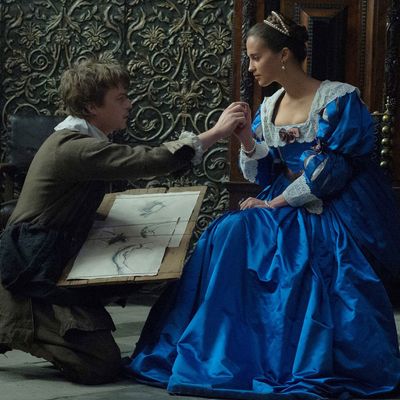
Has there ever been a film as enjoyably cursed as Tulip Fever? A period romance about a painter and his married muse who try to play the tulip market, Tulip Fever at least had an auspicious debut: Dreamworks optioned the 2000 novel by Deborah Moggach at the proof stage, long before it would become a best seller, and some of the biggest names in Hollywood flirted with adapting it. Four years later, Tulip Fever nearly got off the ground with Jude Law and Keira Knightley starring and Shakespeare in Love director John Madden at the helm, but shortly after planting 12,000 tulip bulbs at the start of production, the British government closed a critical tax loophole that blew up the budget, closed down the film, and left all those poor little tulips to wither.
Call it the Tulip Fever cycle: Every time this movie is ready to bloom, someone comes along to sow the crop with salt. It took nearly a decade more for a director and cast to finally stick, but in 2013, producer Harvey Weinstein and director Justin Chadwick (The Other Boleyn Girl) set Dane DeHaan and Alicia Vikander to play the movie’s leads. In the middle of 2014, they filmed it, and by the end of that year, they had a cut ready.
And then? More aborted attempts to bloom, and a hell of a lot more salt. In May 2015, a month after Ex Machina made Vikander white-hot, Weinstein trotted her out at a Cannes press gathering to promote Tulip Fever, which he promised would be coming soon. It didn’t. Rumored for a November release, it quietly slipped off the Weinsteins’ calendar, even as The Danish Girl came out that season and made Vikander an Oscar winner. The only Weinstein-Vikander collaboration released that year was Burnt, an underperforming Bradley Cooper vehicle that Weinstein had prodded a Vikander cameo in after they worked together on Tulip Fever.
In 2016, the Weinstein Company announced a summer release date, July 15, which at least indicated that Tulip Fever was no longer the awards-season hope it had once been conceived as. Even that plan couldn’t stick, though: The week before release, Tulip Fever was ignominiously shoved off to February 24, 2017. Rumors had been flying over the quality of the film and the health of the Weinstein Company in general — after a tough 2015 winter quarter where the company was hit with layoffs and had a string of underperforming titles, the studio had started offloading shelved movies like the Michelle Williams drama Suite Francaise to Lifetime, rather than put them through a costly theatrical release. And the Weinsteins were no strangers to sitting on a movie well past its expiration date: The studio infamously shelved the John Cusack film Shanghai for five years, releasing it in 2015, well after Cusack’s star power had waned.
Still, all those last-minute delays for Tulip Fever started to make it into an ongoing industry joke: In addition to death and taxes, you could count on Tulip Fever to never actually come out. Sure enough, mere days before the February 24, 2017 release date, the Weinsteins made like Lucy with Charlie Brown’s football and yanked Tulip Fever off the calendar yet again. At this point, the poor little unloved film had become infamous. “I saw a screening of Tulip Fever two years ago,” wrote journalist Karen Han, “and I still have a hard time believing it.” After word broke that the Weinsteins were test-screening one more retooled version of the film in May, Awards Watch’s Erik Anderson tweeted, “First test screening was November … 2014. I think it’s fair to call time of death.”
Is Tulip Fever deserving of this hilariously shoddy treatment? Most of the people I’ve talked to who have seen it describe it as just so-so, a mediocre period drama that’s clearly been recut by its studio a few too many times. Perhaps its status as a ’tweener is why the film simply can’t get off the ground: Tulip Fever isn’t classy enough to be the Oscar-contending drama that Weinstein had hoped to engineer by adding thespians like Judi Dench and Christoph Waltz to the film’s sprawling cast, but it’s also not juicy enough to be the populist hit he wanted when he cast popular-in-2014 figures like Glee’s Matthew Morrison, the Hangover-hot Zach Galifianakis, and Prince Harry’s then-girlfriend Cressida Bonas. So much time has elapsed since then that DeHaan spent the interim shooting Valerian, a megabudget space movie with minor Tulip Fever player Cara Delevingne, which came out last month and bombed.
So when I tell you that just this week, the Weinstein Company pushed Tulip Fever from a limited release on August 25 to a wide release on September 1, I don’t know whether that means you should reserve your ticket, laugh in my face, or both. I know I was amused to find out that after years of showing the film to journalists and then suddenly pulling it back, the Weinsteins have now set a review embargo that will elapse the afternoon of September 1, well after the movie is alleged to start playing for general audiences. But who knows if it actually will? A perverse part of me hopes the cycle will still continue, with contrite ushers entering the theater just as those initial Tulip Fever matinees begin. Why let Tulip Fever come out and be forgettable when it could slip away yet again and be the stuff of legend?

